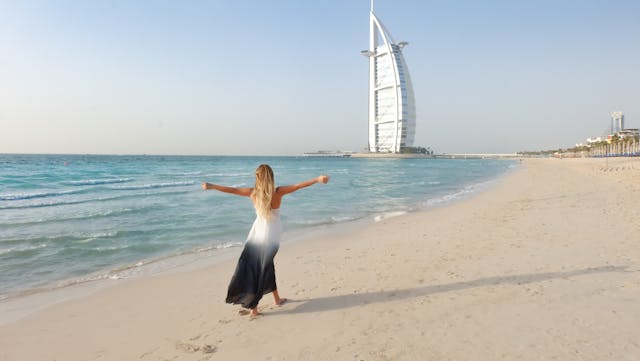Dubai, the modern metropolis known for its record-breaking achievements and stunning skyline, has a unique history deeply intertwined with the sands of the Arabian desert.
The city’s transformation from a humble fishing village to a global hub of commerce and luxury is a testament to human ingenuity and ambition. Let’s delve into the fascinating story of how Dubai was built on sand.
The Origins of Dubai
Dubai’s roots trace back thousands of years, with human presence in the region for over 100,000 years.
However, the Dubai we recognize today emerged around 1,000 years ago. The modern emirate was shaped by Maktoum bin Buti Al Suhail, who began ruling in 1833, setting the stage for Dubai’s evolution into a vibrant city.
The Discovery of Oil and Economic Boom
The turning point in Dubai’s history came with the discovery of oil in the 1960s. This pivotal moment ignited rapid economic growth, propelling Dubai into a new era of development and prosperity.
The influx of wealth and resources fueled ambitious projects that would redefine the city’s landscape.
Land Reclamation Projects
One of the most striking features of Dubai’s transformation is its innovative land reclamation projects. Developers envisioned grand designs to expand the city’s coastline and create artificial islands.
Through a meticulous process involving dredging sand and silt from the seafloor, shaping it with GPS technology, and solidifying the islands with stone, Dubai’s iconic landmarks like the Palm Islands and The World Islands began to take shape.
The Palm Islands and The World Islands
Among the remarkable creations are the Palm Islands, particularly Palm Jumeirah, a palm-shaped island adorned with luxury hotels, apartments, and entertainment venues.
The World Islands, an archipelago designed to resemble a map of Earth’s continents, added a unique touch to Dubai’s coastal landscape. While these projects faced challenges and delays, they stand as testaments to Dubai’s ambition and vision.
Environmental Impact and Sustainability
The rapid development of Dubai has not been without consequences. The construction of artificial islands and urban expansion has raised concerns about environmental impact, particularly on marine wildlife and vegetation.
Scientists are closely monitoring changes in water quality and ecosystem dynamics to ensure the sustainability of these ambitious projects.
Cultural Diversity and International Appeal
Dubai’s growth as a global city is mirrored in its diverse population and international appeal. With a melting pot of cultures, languages, and cuisines, Dubai has become a cosmopolitan hub attracting visitors and expatriates from around the world.
The city’s vibrant tourism industry and thriving economy have solidified its position as a dynamic and multicultural destination.
Looking Ahead
As Dubai continues to evolve and expand, balancing progress with environmental stewardship and sustainable development will be key.
The city’s journey from humble beginnings to a modern marvel built on sand is a testament to human innovation and perseverance. Dubai’s story serves as an inspiration for cities worldwide, showcasing the transformative power of vision, determination, and creativity.
In conclusion, Dubai’s remarkable rise from the sands of the desert to a global powerhouse is a testament to human ambition and resilience.
The city’s evolution reflects a blend of tradition and modernity, innovation and sustainability, making it a symbol of progress and possibility in the 21st century.

